Causality Study of Trade and Economic Growth of Nepal
Main Article Content
Abstract
This paper investigates the impact of foreign trade on economic growth in Nepal. The objective of this study is to identify the causal relationship between the foreign trade and economic growth of Nepal. For this achieving the purpose, secondary data of 1975 to 2017 have been used, which are referenced from the Nepal Rastra Bank. The analysis methods has been used the Auto Regression Model and Granger-Causality Tests for achieved the results. The result of the study reveals that there is a significant relationship between the export and economic growth of Nepal. The result showed when export increases by 1 unit then GDP increases by 0.58 units in short run. It indicates that current GDP growth is also affected by past year’s export. Similarly, Granger causality test also shows that export trade caucused to economic growth (p=0.0071) and foreign loan also caucused to economic growth (p=0.0410). It shows that there is a unidirectional causality with economic growth in Nepal. Hence, this study suggests that the policy makers should focus on exportable products which have potential for larger scale productions within the country, and comparative advantage for export trade as well as economic growth in Nepal. Moreover, national economic policy should be focused on investment friendly environment and creating a trust for foreign loan in Nepal.
Downloads
Article Details

This work is licensed under a Creative Commons Attribution-NonCommercial-NoDerivatives 4.0 International License.
How to Cite
References
ADB, (2019). Potential Exports and Nontariff Barriers to Trade of Nepal National Study; website: https://www.adb.org/sites/default/files/publication/507016/nepal-exports-nontariff-barriers-trade-study.pdf
Customs Tariff (2020/2021). Published by Department of Customs, Kathmandu of Nepal.
Ghimire, R.(2009).Trade openness and GDP growth in Nepal: A granger causality test. The Economic Journal of Nepal, 32(126), 87-109.
Hollis Chenery (1961). “Comparative Advantage and Development Policy", American Economic Review LI, No. 1
Kafle, A. (2017). Nepal’s Foreign Trade: Present Trends. International Journal of Latest Engineering and Management Research 2-(11).1-7.
Kehar, S. and Inder, S.(2003).Prospects of Agricultural Exports of India: A Composite Index Approach, Indian J. Agric Econ., Oct-Dec, 5&4: 781-799.
Nepal Trade Policy Review (2018) , published by Government of Nepal Ministry of Industry, Commerce and Supplies Singha Durbar, Kathmandu, Nepal
NRB, (2019). The status of Remittance in Nepal, Nepal Rastra Bank, Baluwatar Kathmandu
Nepal Trade policy Review (2018). Published by Government of Nepal Ministry of Industry, Commerce and Supplies Singha Durbar, Kathmandu, Nepal
Nepal Foreign Trade trend Study (2020). Published by Nepal Rastra Bank, kathmandu
Poudel, Sri R. (1988). Foreign Trade, Aid and Development in Nepal. New Delhi: Common Wealth Publishers
Ricardo David (1817). The principles of Political Economy and Taxation Shameek, M. and Sahana M., 2012, Overview of India’ Export Performance: Trends and Drivers, Indian Institute of Management, Working Paper No. 363.
Singh, D. A. and Khanal, R. K. (2010). Pattern of Indo-Nepal Trade After 1990. Socioeconomic Voice. Downloaded from http://www.indiastat.com/article/18/ arjun/fulltext.pdf.
Sharma, O. & Bhandari, R. (2005). Foreign trade and its effects on Nepalese Economic development. The Journal of Nepalese Business Studies, 2(1), 13-32.
Thirlwall, A. P. (1999). Reflections on the concept of Balance of Payments Constrained Growth, Journal of post Keynesian Economics, 19(3), 337-385.
Todaro, M. P. & Smith, S.C. (2009). Economic development. New Delhi: Pearson Education





